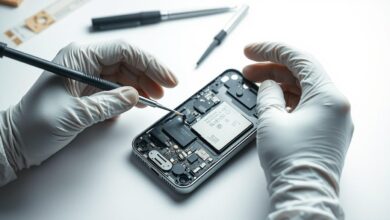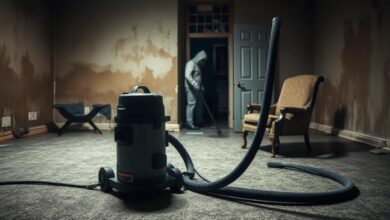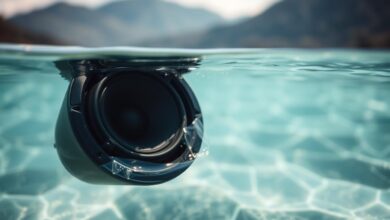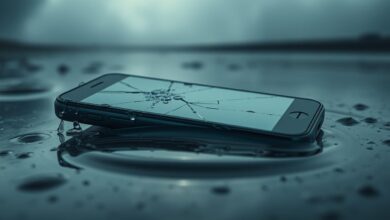water eject iphone
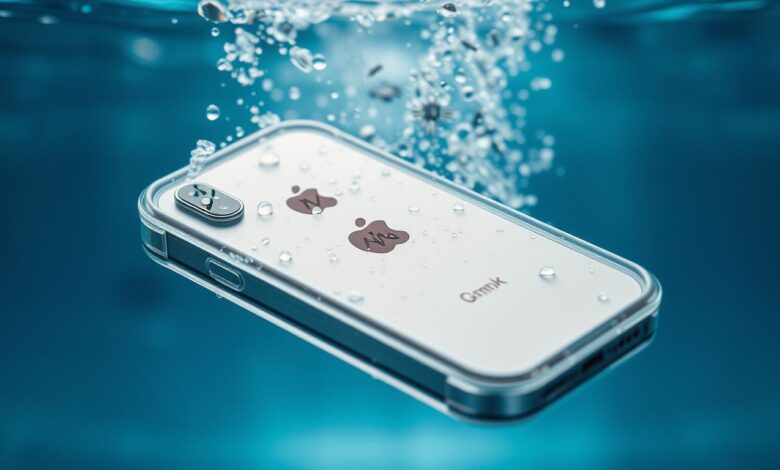
If you use an iPhone, you might have faced the scary situation of liquid damage. It could be from accidentally dropping it in water or spilling something on it. Preventing liquid damage is very important. I’ll show you how to safely get liquid out of your phone.
If your iPhone gets wet, you need to act fast to avoid damage. Keeping your iPhone in good shape is crucial. We’ll look at the best ways to remove liquid and protect your iPhone.
Key Takeaways
- Understand the risks associated with liquid exposure
- Learn the steps to safely remove liquid from your iPhone
- Discover best practices for iPhone maintenance
- Prevent liquid damage with simple precautions
- Explore methods for drying out your iPhone
Understanding Water Resistance in iPhones
Knowing about water resistance in iPhones can save you from a big repair bill. Water resistance in iPhones has grown a lot over time. It’s key to understand what it means for keeping your device safe.
IP Ratings Explained
The IP rating, or Ingress Protection rating, shows how well a device can handle solids and liquids. For iPhones, this rating is very important. It tells you how well your device can handle water.
For example, an IP68 rating means your device can handle dust and can be underwater for over 1 meter.
Evolution of Water Resistance in iPhone Models
Apple has made iPhones much more water-resistant over the years. Early models had little protection, but newer ones have better sealing and coatings. The iPhone 12 series and later have seen big improvements in water resistance.
Limitations of Water Resistance
Even though iPhones are more water-resistant, it’s not perfect. Water resistance can get worse over time because of wear and tear. It’s not a complete shield against all water.
Things like water pressure, temperature, and other substances can also impact how well your device can handle water.
The Dangers of Water Damage to Your iPhone
Water damage can cause big problems for iPhones. It can lead to expensive fixes or make your phone useless. Knowing these risks helps prevent damage and keeps your phone working well.
Common Internal Components Affected
Water can harm many parts inside your iPhone. This includes the logic board, battery, and display. Water can cause corrosion, leading to short circuits and damage to your phone’s protection.
| Component | Potential Damage |
|---|---|
| Logic Board | Corrosion, Short Circuits |
| Battery | Corrosion, Swelling, Failure |
| Display | Water Spots, Display Failure |
Short and Long-term Damage Potential
Water damage can happen right away or later. Quick problems might be broken parts or a phone that won’t work. But, long-term damage can cause corrosion and harm to your phone’s parts, affecting its protection.
Warning Signs of Water Damage
Spotting water damage early is key. Look for corrosion, red liquid indicators, and strange phone behavior. Regular checks can help find problems early and save on repair costs.
How to Water Eject iPhone Using Built-in Features
To save your iPhone from water damage, use its built-in water ejection feature. This is great if you accidentally dropped it in water or got it wet.
Using the Shortcuts App Method
The Shortcuts app makes it easy to eject water from your iPhone. You can create a shortcut that plays a sound to push water out of the speakers.
First, make sure your Shortcuts app is updated. Then, make a new shortcut to play a sound frequency that helps eject water.
Step-by-Step Water Ejection Process
Here’s how to use the Shortcuts app to eject water:
- Open the Shortcuts app and make a new shortcut.
- Add an action to play a sound file with a specific frequency (usually around 165Hz).
- Save the shortcut and run it to start the water ejection process.
- Place your iPhone on a flat surface and let the sound play for a few minutes.
- Repeat the process a few times to ensure maximum water ejection.
Effectiveness and Limitations
The success of this method depends on how much water your iPhone got and the model. It helps remove water from speakers but might not fix damage to other parts.
Key benefits:
- Easy to use with the Shortcuts app.
- Can be effective for removing water from speakers.
Limitations:
- May not work for extensive water damage.
- Not a substitute for professional repair or maintenance.
Knowing what the built-in water ejection feature can and can’t do helps keep your iPhone safe. It can help reduce damage from water exposure.
Setting Up the Water Eject Shortcut
The Water Eject shortcut is a great tool for iPhone users. It helps protect your device from water damage. Setting it up is simple and can save your iPhone from water harm.
Downloading the Water Eject Shortcut
To start, download the Water Eject shortcut from a trusted source. You can find it in the Shortcuts app or on a reliable website. Make sure to download from a safe place to avoid security problems. After downloading, the shortcut will be in your Shortcuts app, ready to use.
Configuring Shortcut Settings
Once you’ve downloaded it, setting up the Water Eject shortcut is easy. Open the Shortcuts app and find the Water Eject shortcut. Tap on it to open its settings. You can adjust the sound settings to better eject water. Always test the shortcut to make sure it works right.
Troubleshooting Common Setup Issues
Setting up the Water Eject shortcut usually goes smoothly, but problems can happen. If the shortcut doesn’t show up or doesn’t work, check a few things. Make sure your Shortcuts app is updated and you’ve given it the right permissions. If you still have trouble, try reinstalling the shortcut or ask for help online.
By following these steps, you can set up the Water Eject shortcut on your iPhone. This will help protect your device from water damage. Remember to test the shortcut often to keep it working well.
Manual Methods to Remove Water from Your iPhone
Water can harm your iPhone, but you can take steps to protect it. If your iPhone gets wet, act fast to prevent damage. Here, we’ll look at ways to dry your device.
The Rice Method: Does It Really Work?
The rice method is a common way to dry wet electronics. It uses uncooked rice to soak up moisture from your iPhone. But, its success is up for debate. Some people say it works, while others doubt it.
To try it, put your iPhone in a container filled with uncooked rice. Make sure it’s fully covered.
Pros: It’s easy to find and cheap.
Cons: Rice dust might get into your iPhone’s openings and cause more harm.
Using Silica Gel Packets
Silica gel packets are another option to dry your iPhone. They’re better at controlling humidity than rice. Put your iPhone in a sealed container with several silica gel packets.
Advantages: They’re more effective at drying and less likely to let dust in.
Disadvantages: They might be harder to find than rice, and they can be small and easy to lose.
Gentle Shaking and Positioning Techniques
Shaking your iPhone gently and changing its position can help remove water. Tilt it to let gravity help push water out of the ports. But, be careful not to shake it too hard, as it could damage it more.
| Method | Effectiveness | Ease of Use |
|---|---|---|
| Rice Method | Moderate | Easy |
| Silica Gel Packets | High | Moderate |
| Gentle Shaking | Low to Moderate | Easy |
These methods can help with water damage, but they’re not perfect. For serious water damage, you might need a professional to fix your iPhone.
Third-Party Apps for Water Ejection
Third-party apps offer extra ways to get water out of iPhones. They’re great when built-in methods don’t work or aren’t available.
Top Water Ejection Apps Review
Many apps on the App Store claim to help remove water from iPhones. Water Eject and Sound Frequency Generator are among the best. They use sound frequencies to push water out of the speakers.
I’ve looked at these apps. They might help, but how well they work depends on the water amount and iPhone model.
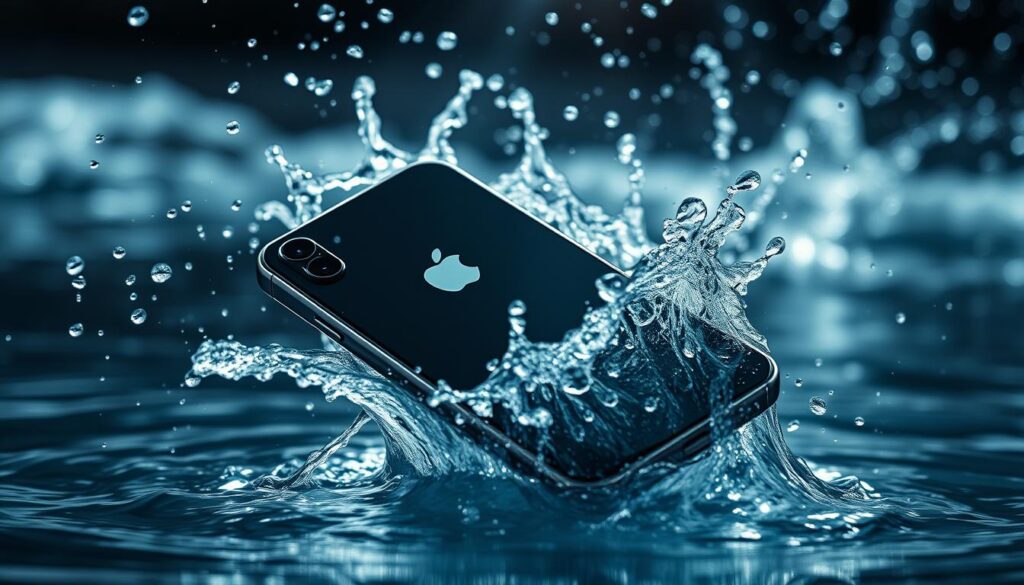
Comparing App Effectiveness
How well these apps work can vary a lot. It depends on the sound frequency range, speaker quality, and water amount. Apps with a wide sound frequency range usually work better.
- Apps with higher frequency sounds may be more effective for smaller water droplets.
- Apps that can adjust frequency and amplitude may offer better results for different types of water exposure.
Safety Considerations When Using Third-Party Solutions
Third-party apps can be useful, but safety is key. Using unknown apps can damage your device or risk its security. Always get apps from the App Store and check user reviews.
When using these apps for water eject iphone tasks, protect your device. Use a case and avoid more water exposure.
Emergency Response: What to Do Immediately After Water Exposure
Knowing the right steps after your iPhone gets wet is crucial. It can mean the difference between a working phone and a big repair bill. Quick action is key to prevent damage.
First 60 Seconds: Critical Actions
Act fast after your iPhone gets wet. Get it out of the water and dry it gently with a soft cloth. Don’t press or touch the screen yet.
Critical Steps:
- Immediately remove your iPhone from the water.
- Gently pat the exterior dry with a soft cloth.
- Avoid pressing or touching the screen.
Common Mistakes to Avoid
Many people charge their iPhone or use it right after getting wet. This can lead to short circuits and more damage.
| Action | Consequence |
|---|---|
| Charging the iPhone | Potential short circuit |
| Using the iPhone | Increased risk of damage |
When to Power Off vs. Keep On
Deciding whether to turn off or keep your iPhone on depends on its condition. If it’s on, immediately turn it off to avoid short circuits. If it’s off, wait until it’s dry before turning it back on.
By following these steps, you can help your iPhone survive after getting wet. Regular care and avoiding liquids can also help keep your iPhone working longer.
Drying Methods That Can Damage Your iPhone
After your iPhone gets wet, it’s key to stay away from certain drying methods. Quick drying might seem right, but some ways can really hurt your phone. This can mess up your iPhone’s safety and how well it works.
Heat Sources to Avoid
Don’t use a hair dryer or oven to dry your iPhone. The heat can dry the water too fast, harming your phone’s inside parts or bending it. It’s safer to let your iPhone dry naturally. This way is slower but keeps your phone safe.
Compressed Air Risks
Compressed air might look like a quick fix to get water out. But, the strong air can push water deeper into your phone or hurt its tiny parts. Also, the air might have moisture or dirt that makes things worse for your phone.
Why Cotton Swabs and Tissues Can Cause Problems
Cotton swabs and tissues aren’t good for drying your iPhone either. They can leave lint or fibers that block your phone’s ports or get stuck in small spaces. Plus, putting cotton swabs in your phone’s openings can push water around or damage its inside parts. For the best device protection, it’s better to avoid these and let your iPhone dry naturally or use the right drying methods.
In short, when drying your iPhone, be careful and avoid methods that could do more harm. Knowing what not to do helps protect your device and keeps it working well for longer.
Water Resistance vs. Waterproof: Understanding Your iPhone’s Capabilities
It’s important to know the difference between water resistance and waterproofing for iPhone users. While many iPhones can handle water well, they are not completely waterproof. Water resistance means a device can handle water under certain conditions. Waterproofing means it can handle water completely, which no iPhone can do.
Maximum Depth and Duration Ratings
iPhone models have an IP (Ingress Protection) rating for dust and water resistance. For example, an IP68 rating means it can handle water over 1 meter deep. Apple’s official documentation shows how deep and long each iPhone can stay underwater. For instance, the iPhone 14 Pro can go up to 4 meters deep for 30 minutes.
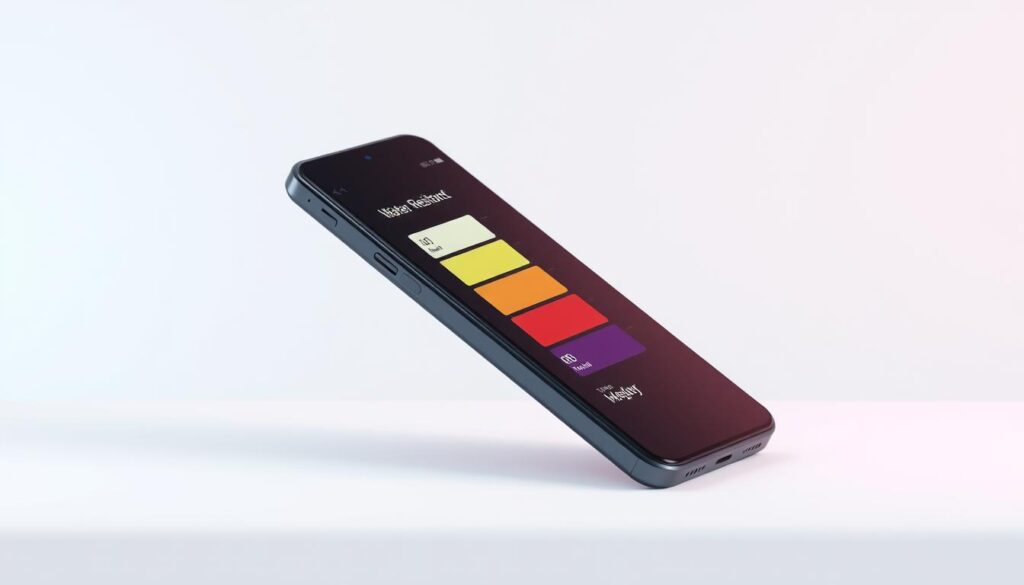
How Age Affects Water Resistance
As your iPhone gets older, its water resistance can decrease. This is due to wear and tear, environmental factors, and seal damage. So, older iPhones may not resist water as well as newer ones.
Activities Safe for Your iPhone
While iPhones can handle some water, certain activities are risky. Swimming or using high-pressure water jets with your iPhone is not safe. Here’s a table of safe activities and conditions for your iPhone:
| Activity | Safety Level | Precautions |
|---|---|---|
| Accidental splashes | Safe | Dry the iPhone promptly |
| Rain exposure | Generally safe | Avoid prolonged exposure |
| Swimming | Not recommended | Use a waterproof case |
| High-pressure water jets | Not recommended | Avoid exposure |
In conclusion, knowing your iPhone’s water resistance is key to keeping it safe. By understanding its limits and safe uses, you can protect it from water damage.
Preventing Water Damage in the First Place
By taking the right steps, you can lower the chance of water damage to your iPhone. It’s key for every iPhone user to act early and protect their device.
Protective Cases and Covers
Getting a top-notch protective case or cover is a smart move. Look for ones that are made to be waterproof or water-resistant. They help keep your iPhone safe from spills or rain.
Waterproof Accessories Worth Investing In
There are many waterproof accessories that can protect your iPhone. You can find waterproof bags, pouches, and phone wallets for wet places like beaches or pools.
Some popular options include:
- Waterproof phone cases with built-in screen protectors
- Underwater phone housings for photography
- Water-resistant phone wallets with card slots
Situations That Require Extra Caution
Some situations call for extra care with your iPhone to avoid water damage. This includes being near water, like pools or lakes, and activities like swimming or surfing.
To stay safe, use a waterproof accessory or keep your iPhone away when near water.
How Salt Water and Chlorine Affect Water Ejection
Being near salt water or chlorine can make it harder to get water out of your iPhone. This is especially true when you’re at the beach or pool. The type of water you’re in can really affect your device.
Special Considerations for Beach and Pool Exposure
Salt water and chlorine can harm your iPhone because they cause corrosion. If your iPhone gets wet in either, you need to act fast to lessen the damage.
Key differences between salt water and chlorine exposure:
| Exposure Type | Immediate Effects | Long-term Risks |
|---|---|---|
| Salt Water | Corrosion, short circuits | Lasting damage to components |
| Chlorine | Accelerated corrosion, damage to seals | Increased risk of component failure |
Additional Cleaning Steps Required
After being in salt water or chlorine, clean your iPhone gently with fresh water. This can help remove harmful substances. But, don’t use cleaning products or put anything in the ports.
Corrosion Prevention Techniques
To stop corrosion, dry your iPhone well. You can use a desiccant or uncooked rice to soak up moisture. But, be careful not to push things into the ports. Also, check your iPhone often for corrosion and fix it right away to avoid more damage.
Knowing how salt water and chlorine affect your iPhone can help. Taking the right steps can make it easier to get water out and protect your device.
When to Seek Professional Help
Water damage can be a big problem for iPhone users. Knowing when to get expert help is key for device protection and keeping your iPhone working well.

Signs That DIY Methods Aren’t Enough
If DIY water removal methods don’t work, it’s time to get professional help. Look out for these signs:
- Persistent water damage symptoms
- Corrosion on internal components
- Failure to turn on or boot up
Apple Store vs. Third-Party Repair Options
You have two main choices: the Apple Store or third-party repair services. The Apple Store uses iPhone maintenance with real parts and keeps your warranty valid. But, it might cost more. Third-party shops might be cheaper but the quality and warranty can vary.
Expected Costs and Timeframes
Repair costs can change a lot based on the damage and the service. Prices usually range from $100 to over $500. Repair times also differ, with Apple Store repairs taking a few days to a week. Third-party services might be faster.
Knowing these details helps you choose the right place for your water-damaged iPhone. It ensures good device protection and iPhone maintenance.
AppleCare+ and Warranty Considerations for Water Damage
Protecting your iPhone from water damage is crucial. Knowing your AppleCare+ coverage is key. AppleCare+ is an extended warranty that covers accidental damage, including water damage.
What’s Covered and What’s Not
AppleCare+ covers up to two incidents of accidental damage, like water damage, for a fee. But, not all water damage is covered. Damage from salt water or other liquids not listed might not be covered.
How to Check Your Coverage Status
To see if you have AppleCare+, follow these steps:
- Go to the Apple Support website.
- Sign in with your Apple ID.
- View your AppleCare+ coverage details.
Documentation Tips for Claims
When you file a claim for water damage, have your documents ready. You’ll need:
- Proof of purchase
- Details of the damage
- Any supporting photos or videos
| Coverage Aspect | Description |
|---|---|
| Accidental Damage Coverage | Covers up to 2 incidents |
| Service Fee | $29 per incident (plus tax) |
| Required Documentation | Proof of purchase, damage details, supporting media |
Understanding your AppleCare+ coverage helps protect your iPhone from water damage. By following the right steps for a claim, you can avoid the financial hit of water damage.
Latest iPhone Models and Their Water Resistance Capabilities
Recent iPhone models, like the iPhone 13, 14, and 15 series, have better water resistance. Apple keeps working to make their devices more durable and resistant.
iPhone 13/14/15 Series Water Resistance Specs
The iPhone 13, 14, and 15 series have better water resistance. They are rated IP68 under the IEC standard 60529. This means they can handle being underwater up to 4 meters for 30 minutes. But, Apple warns that water resistance is not permanent and may decrease over time.
Improvements Over Previous Generations
The latest iPhone models have made big strides in water resistance. Apple has improved design and engineering. They use better sealing and more resistant materials.
Real-World Performance vs. Laboratory Ratings
Lab tests show how water-resistant a device is, but real-world use can differ. Water pressure, temperature, and other substances in the water can impact an iPhone’s resistance. Users should remember that dropping their iPhone in water still poses a risk, even with the latest models.
In conclusion, the latest iPhone models have better water resistance. But, it’s important for users to know the limits and take steps to protect their devices.
Conclusion: Keeping Your iPhone Safe and Dry
Keeping your iPhone safe from water is very important. Learning how to remove water from your iPhone and taking care of it can help a lot. This can lower the chance of water damage.
There are many ways to protect your iPhone from water. You can use built-in features, manual methods, or apps. Also, using protective cases and being careful where you are can help a lot.
It’s also good to know how water-resistant your iPhone is. Knowing this can help you avoid damage. Taking steps to prevent water damage and knowing what to do if it happens can keep your iPhone working well.
Following the tips in this article can make using your iPhone worry-free, even when there’s water around. Protecting your device is easy with the right steps. With the knowledge you gain, you can keep your iPhone safe and dry.
FAQ
What is the purpose of water ejecting my iPhone?
Water ejecting your iPhone helps remove water inside. This reduces damage to its parts and keeps it working longer.
How do I know if my iPhone is water-resistant?
Look at your iPhone’s IP rating. It shows how well it resists water and dust. Most iPhones are water-resistant, but the level varies by model.
Can I use a third-party app to eject water from my iPhone?
Yes, there are apps that can help remove water from your iPhone. But, make sure they are safe and effective before using them.
Is it safe to use the rice method to dry my iPhone?
The rice method is a common fix, but its success is debated. It’s best to avoid rice because it can leave dust that harms your iPhone.
How can I prevent water damage to my iPhone?
Use a protective case and avoid water exposure. Also, consider waterproof accessories. Be careful near water, like pools or beaches.
What should I do immediately after my iPhone is exposed to water?
Turn off your iPhone, remove accessories, and dry it gently. Don’t use heat or compressed air. Use a water eject shortcut or get professional help if needed.
Does AppleCare+ cover water damage?
AppleCare+ covers accidental damage, including water damage. But, it has conditions and limits. Check your coverage to know what’s included.
How do salt water and chlorine affect my iPhone’s water resistance?
Salt water and chlorine can damage your iPhone’s water resistance. Clean it quickly and take steps to prevent corrosion if exposed.
Can I repair my iPhone’s water damage myself?
DIY methods can help, but severe damage might need a pro. If unsure, get help from an Apple Store or authorized repair center.
What are the signs that my iPhone has suffered water damage?
Look for corrosion, visible water, and issues like faulty speakers or charging ports. If you see these signs, act fast to prevent more damage.
